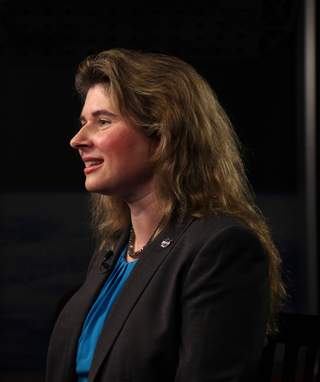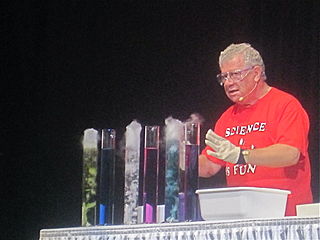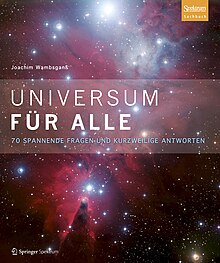
The Space Telescope Science Institute (STScI) is the science operations center for the Hubble Space Telescope (HST), science operations and mission operations center for the James Webb Space Telescope (JWST), and science operations center for the Nancy Grace Roman Space Telescope. STScI was established in 1981 as a community-based science center that is operated for NASA by the Association of Universities for Research in Astronomy (AURA). STScI's offices are located on the Johns Hopkins University Homewood Campus and in the Rotunda building in Baltimore, Maryland.
The Graduate School and University Center of the City University of New York is a public research institution and postgraduate university in New York City. Serving as the principal doctorate-granting institution of the City University of New York (CUNY) system, The CUNY Graduate Center is classified among "R1: Doctoral Universities – Very High Research Activity". The school is situated in the landmark B. Altman and Company Building at 365 Fifth Avenue in Midtown Manhattan, opposite the Empire State Building. The CUNY Graduate Center has 4,600 students, 31 doctoral programs, 14 master's programs, and 30 research centers and institutes. A core faculty of approximately 140 is supplemented by over 1,800 additional faculty members from CUNY's eleven senior colleges and New York City's cultural and scientific institutions.

New Mexico State University is a public land-grant research university in Las Cruces, New Mexico. Founded in 1888, it is the state's oldest public institution of higher education and one of two flagship universities in New Mexico. NMSU has campuses in Alamogordo, Doña Ana County, and Grants, as well as research centers and programs in all 33 counties in the state.

The Astronomical Society of the Pacific (ASP) is an American scientific and educational organization, founded in San Francisco on February 7, 1889, immediately following the solar eclipse of January 1, 1889. Its name derives from its origins on the Pacific Coast, but today it has members all over the country and the world. It has the legal status of a nonprofit organization.

MIT World Peace University,(MIT-WPU) is a private university located in Kothrud, Pune, India. It is a part of the MIT Group of Institutions.
The Medical Scientist Training Programs (MSTPs) are dual-degree training programs that streamline the education towards both clinical and research doctoral degrees. MSTPs are offered by some United States medical schools, who are awarded financial support from the National Institute of General Medical Sciences, a branch of the National Institutes of Health (NIH). The goal of these training programs is to produce physician scientists who can translate laboratory discoveries into effective treatments for patients.
The Klaus Tschira Stiftung (KTS) is a German foundation established by the physicist Klaus Tschira in 1995 as a non-profit organization. Its primary objective is to support projects in the natural and computer sciences as well as mathematics. The KTS places strong emphasis on the public understanding in these fields. Klaus Tschira’s commitment to this objective was honored in 1999 with the "Deutscher Stifterpreis" by the German National Academic Foundation. The KTS is located at the Villa Bosch in Heidelberg, Germany, the former residence of Nobel Prize laureate for chemistry Carl Bosch (1874–1940).

Andrew Fraknoi is a retired professor of astronomy recognized for his lifetime of work using everyday language to make astronomy more accessible and popular for both students and the general public. In 2017 Fraknoi retired from his position as Chair of the Department of Astronomy at Foothill College. In retirement he continues to teach through the Fromm Institute for Lifelong Learning and the Osher Lifelong Learning Institute at San Francisco State University, to give public lectures, and to add to his body of written work. He is the recipient of numerous awards and honors in his field.

Michelle Lynn Thaller is an American astronomer and research scientist. Thaller is the assistant director for Science Communication at NASA's Goddard Space Flight Center.
National Science Day is celebrated in India on February 28 each year to mark the discovery of the Raman effect by Indian physicist Sir C. V. Raman on 28 February 1928.

The UNC Claude A. Adams Jr. and Grace Phillips Adams School of Dentistry is the school of dentistry of the University of North Carolina. It is located in Chapel Hill, North Carolina, United States. It is currently ranked second among all dental schools in the U.S. and is consistently ranked among the best in the world according to two independent rankings. Founded in 1950 as the UNC School of Dentistry, it was the only dental school in North Carolina until 2011, when East Carolina University School of Dental Medicine became the second. In 2019, the school received its largest single donation of $27.68 million, resulting in a name change to honor Dr. Claude A. Adams Jr. and Grace Phillips Adams. Dr. Adams was a North Carolina dentist that practiced in Durham until his death in 2018.

Bassam Z. Shakhashiri is a professor of chemistry at the University of Wisconsin-Madison, where he is the holder of the William T. Evjue Distinguished Chair. An active advocate for science education, he is the author of multiple books of chemical demonstrations. He was the 2012 president of the American Chemical Society and has received numerous awards and honors.

The University of Colorado Denver is a public research university located in downtown Denver, Colorado. It is part of the University of Colorado system. Established in 1912 as an extension of the University of Colorado Boulder, CU Denver attained university status and became an independent institution in 1973. CU Denver is the largest research university in Colorado, and is classified among R1: Doctoral Universities - Very High Research Activity. The university's graduate programs award more master's degrees than any other institution in the state, serving roughly 5,000 students annually.
Physics outreach encompasses facets of science outreach and physics education, and a variety of activities by schools, research institutes, universities, clubs and institutions such as science museums aimed at broadening the audience for and awareness and understanding of physics. While the general public may sometimes be the focus of such activities, physics outreach often centers on developing and providing resources and making presentations to students, educators in other disciplines, and in some cases researchers within different areas of physics.

Louise Tolle Huffman is an American teacher with over 30 years of teaching experience with many years focused on polar science and climate studies, and has written educational outreach books and articles on Antarctica. She is the Director of Education and Outreach for the US Ice Drilling Program Office (IDPO), responsible for outreach efforts highlighting IDPO scientists and their research results.

The Cyprus Space Exploration Organisation (CSEO) is a non-governmental, nonprofit, science organisation, based in Cyprus, with a global scope of service and activities. Its main functions are research and development, space advocacy, and international cooperation in the field of space exploration, astronautics and astronomy. Education and outreach are also an important part of its mission as International Astronomy Education Center.

The Pittsburgh Quantum Institute (PQI) is a multidisciplinary research institute that focuses on quantum sciences and engineering in the Pittsburgh region. It is a research-intensive cluster.

Henry B. Throop, is an American astronomer and planetary scientist who specializes in the dynamics of rings and dust in the outer solar system. Throop is a member of the science team for NASA's New Horizons mission to Pluto and the Kuiper Belt, and has been involved with NASA missions throughout the solar system. Throop lives in Washington, DC where he runs NASA's science programs in the outer solar system. He has done extensive education and outreach around the world, having spent nearly a decade as an astronomer living in South Africa, India, and Mexico. The asteroid 193736 Henrythroop is named after him.
John Mulchaey is an American astrophysicist working as the science deputy of the Carnegie Institution for Science and the director and Crawford H. Greenewalt Chair of the Carnegie Observatories, the Institution’s division for astronomy and astrophysics research.
















